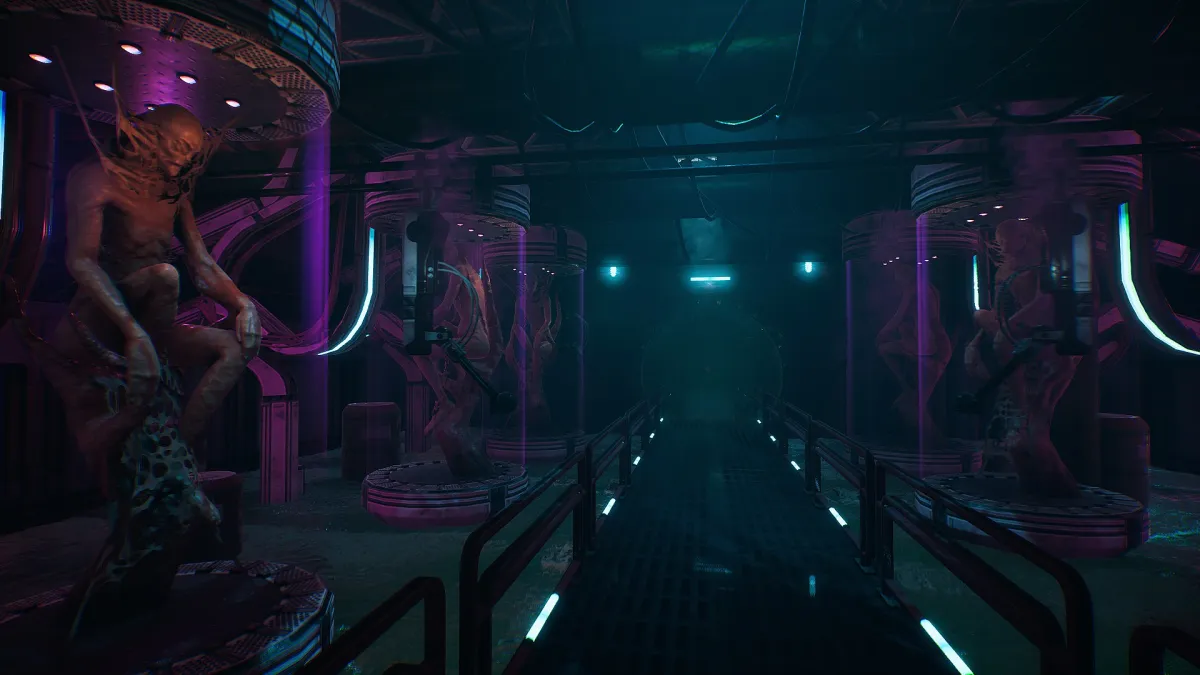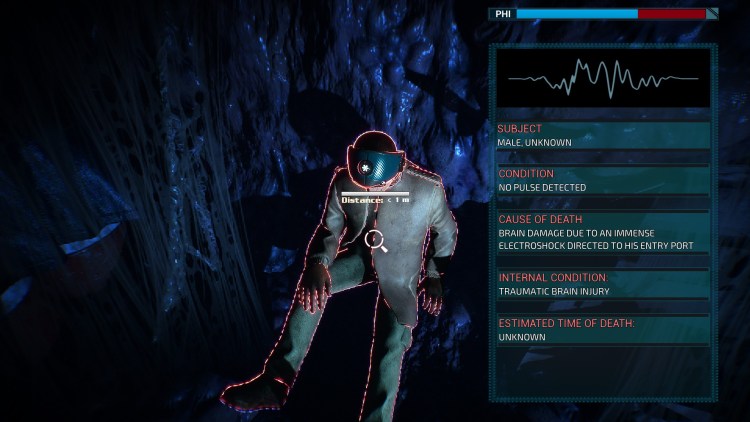It’s almost Halloween, and you know what that means! It’s time to review another Cthulhu-mythos walking simulator with some puzzles here and there! Transient is the successor to the game Conarium, although it requires no familiarity with it. The game might be just a few hours long, but it’s clever, imaginative, creative, and downright gorgeous. All of that makes it very much worth a playthrough for anyone who likes interactive stories. Even if the game has no scares to speak of.
Transient places you in the role of Randolph Carter, a member of a four-person hacking team that does things in a rather unorthodox way. And by “unorthodox,” I mean that the dude might be a bit of a necromancer. The story begins in media res whilst Carter is angrily interrogated by an alien being who demands to know how he traveled beyond his earth flesh and explored the vastness of the great wherever. From there, we’re taken back to the beginning, when Carter and his teammates have found more than they bargained for after their most recent heist.
The storytelling in Transient very much wants you to be confused before it gives you the information necessary to piece it all together. The game’s story openly states that it mixes HP Lovecraft and cyberpunk and that’s undeniably true. Surprisingly, though, it does it rather well. The plot is unique and intriguing and I found myself drawn to the narrative as it unfolded. The story does end somewhat anticlimactically, but it was still worthwhile overall. The presentation is equally good, if not better, as well. The game is fully voice-acted with solid performances. And the visuals are wonderful. Strange alien planets, neon-drenched cyberscapes, dingy interiors. Everything was brought to life with talent and love.
Riddle me this
Although I’d partially classify Transient as a walking sim, that isn’t strictly accurate. There are puzzles in the game, although they dominate the earlier part. Some of them are fairly challenging too; they just give way either to different gameplay sections or straight-up narrative ones later on. The puzzles are well-crafted though and they’re different enough from each other that it’s easy to look forward to the next one. Carter has a Perception Heightening Implant that he can use to scan environments for a bit of detective work. This is pretty neat, but much like every other mechanic in the game, you won’t be seeing it very often.
Still, there’s a very surprising amount of variety when it comes to Transient‘s gameplay. You’ll solve puzzles, explore environments for clues, and play some truly surprising minigames along the way. The first minigame is this cute hacking puzzle where you need to move through a maze while cracking passwords that show up when you get detected by programs. There are only a couple of these, but they’re fun and fairly interesting. Then there are the two fake video games you’ll find when you’re investigating the whereabouts of Carter’s hacker buddies who also happens to be a game dev. These are some of the highlights of the entire experience.
One is an Alone in the Dark style game with era-appropriate graphics where you explore a haunted mansion and fight monsters with a knife while watching via fixed camera angles. It’s just awesome. The other is a first-person game that pays obvious homage to System Shock and has you looking for keys while blasting robots with a gun and using a crowbar while trying to conserve ammo. Almost everything you do in Transient just oozes fun, and there’s practically no repetition to speak of. The only other gameplay mechanic that comes to mind is when you make Carter’s hallucinogenic concoctions in his lab. There’s just so much variety and personality packed into the game’s short playtime.
Take a look around
Naturally, that variety extends to Transient‘s environments. You never stay in any one place for very long and you typically won’t visit a location more than twice. The place you’ll see the most is Carter’s apartment, where he’s able to connect himself to cyberspace and create his aforementioned concoctions. Other main locations include the digital places that he finds in cyberspace, an alien planet where he jumps into the body of another lifeform, or a mysterious lab that’s tied to all the strange things happening to him and his team. And, as I said before, I really can’t overstate how excellent the game looks. It’s almost hard to believe an indie team put this together, it’s so lovely. Well, not the faces. Never the faces.
Truth be told, I almost want to play it again just to marvel at the graphics some more. Plus, I missed a fair amount of collectibles and achievements, as there are some goodies squirreled away in Transient that take a bit of a keen eye to find. There are also some documents strewn about that give you a bit more backstory and these are all well-written. But you won’t need that much of a keen eye to make it through the main content. Conarium has a bit of a reputation for its difficult-to-figure-out puzzling and less-than-stellar signposting, but this game completely avoids that issue. You might get briefly stuck on a puzzle, but they can be figured out with a small amount of patience. I did get stuck in one section, though, but that was more due to my own gross negligence than anything else.
I love being impressed by games like Transient, and it really doesn’t disappoint. I do wish it was longer, though, as I wouldn’t expect it to last most people more than 3.5 hours. But the game isn’t even necessarily too short, I just wanted more when it was finished. It might not have a hell of a lot of meat on the bone, but this is a gorgeous, satisfying game with an enjoyable story and some very good game design. I wouldn’t buy it if I was specifically looking for a horror game, but fans of narrative adventures will likely get a kick out of its offerings. Just don’t try what Carter does in the game at home. Necromancy isn’t something that should be fooled with, especially not when you’re mixing it with virtual reality and ancient beings from deep within the vastness of space.











Published: Oct 28, 2020 09:00 am